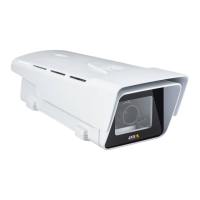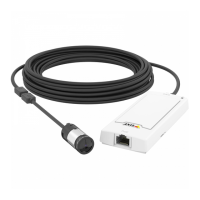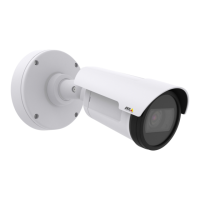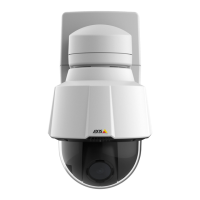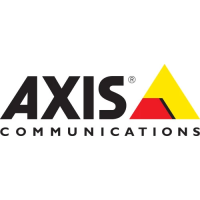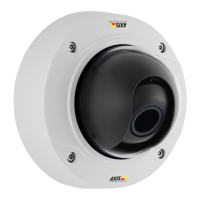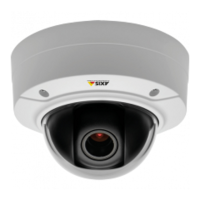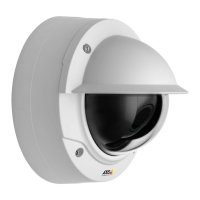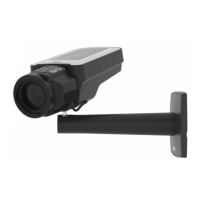
Do you have a question about the Axis P1365 Mk II and is the answer not in the manual?
| Type | IP security camera |
|---|---|
| Certification | EN 55022 Class B, EN 61000-3-2, EN 61000-3-3, EN 55024, EN 61000-6-1, EN 61000-6-2, FCC Part 15 Subpart B Class B, FCC Part 15 Subpart B Class A, ICES-003 Class B, VCCI Class B, RCM AS/NZS CISPR 22 Class B, KCC KN32 Class B, KN35, IEC/EN/UL 60950-1 |
| Languages support | CHI (SIMPL), CHI (TR), DEU, ENG, ESP, FRE, ITA, JPN, KOR, POR, RUS |
| Number of languages | 11 |
| Placement supported | - |
| Connectivity technology | Wired |
| Wide Dynamic Range (WDR) | Yes |
| Maximum resolution | 1920 x 1080 pixels |
| Supported video modes | 1080p |
| Image quality adjustment | Brightness, Colour depth, Contrast, Sharpness |
| Video compression formats | H.264, M-JPEG |
| Supported graphics resolutions | 160 x 90, 1920 x 1080 (HD 1080) |
| Sensor type | CMOS |
| Optical sensor size | 1/2.8 \ |
| Power source | DC, PoE |
| Lens mount interface | CS mount |
| Focus adjustment | 1.3 |
| Focal length range | 2.8 - 8 mm |
| White balance | Auto |
| Camera shutter speed | 1/66500 - 2 s |
| Minimum illumination | 0.01 lx |
| Sample rate | 48 kHz |
| Audio system | 2-way |
| Voice codecs | G.711, G.726 |
| Audio formats supported | LC-AAC |
| USB port | No |
| Interface | RJ-45 |
| RS-422 ports | 2 |
| Headphone outputs | 1 |
| HDMI ports quantity | 0 |
| Security algorithms | 802.1x RADIUS, HTTPS, SSH, SSL/TLS |
| Alert notification type | |
| Password protection type | User |
| Flash memory | 256 MB |
| Internal memory | 512 MB |
| Compatible memory cards | MicroSD (TransFlash), MicroSDHC, MicroSDXC |
| Cabling technology | 10/100Base-T(X) |
| Networking standards | IEEE 802.1x, IEEE 802.3, IEEE 802.3af, IEEE 802.3at, IEEE 802.3u |
| Ethernet interface type | Fast Ethernet |
| Supported network protocols | IPv4/v6, HTTP, HTTPS, SSL/TLS, QoS Layer 3 DiffServ, FTP, CIFS/SMB, SMTP, Bonjour, UPnPTM, SNMP v1/v2c/v3 (MIB-II), DNS, DynDNS, NTP, RTSP, RTP, SFTP, TCP, UDP, IGMP, RTCP, ICMP, DHCP, ARP, SOCKS, SSH |
| Form factor | Box |
| Mounting type | Ceiling/wall |
| Product color | White |
| Housing material | Metal |
| Power consumption (max) | 7.3 W |
| Power consumption (typical) | 4.2 W |
| Power consumption (Power over Ethernet (PoE)) | 3.6 W |
| Storage temperature (T-T) | -40 - 65 °C |
| Operating temperature (T-T) | 0 - 55 °C |
| Operating relative humidity (H-H) | 10 - 85 % |
| Bundled software | AXIS Camera Companion, AXIS Camera Station, Video management software |
| Depth | 205 mm |
|---|---|
| Width | 78 mm |
| Height | 46 mm |
| Weight | 630 g |
Details compliance with CE marking directives and harmonized standards for European markets.
Fulfills applicable standards for EMC in USA, Canada, Europe, Australia/New Zealand, and Japan.
Information on the camera's lithium battery, its expected life, and replacement guidelines.
Guidelines for environmentally safe disposal and recycling of the camera and its components.
Explains hazard levels like DANGER, WARNING, CAUTION, and NOTICE to indicate potential risks.
Defines message levels like Important and Note for product guidance and essential information.
Identifies and describes LEDs, microphone, SD card slot, and various connectors (Network, Audio, I/O, etc.).
Step-by-step guide for safely removing and installing a new camera lens.
Instructions for disconnecting the iris cable, unscrewing the old lens, and attaching a new one.
Guides on selecting and uploading iris configuration files for P-Iris lenses.
How to access the camera's web interface using standard web browsers.
Steps to configure the camera and router for remote access over the internet.
Guide on setting the root password for secure access and preventing eavesdropping.
Configuring power line frequency for image quality and selecting the PTZ operational mode.
Setting the product's resolution/frame rate and an overview of the Live View page interface.
Adjusting image size and enabling Wide Dynamic Range for challenging lighting conditions.
Selecting video stream profiles and activating output ports for external devices.
Utilizing manual trigger for action rules and capturing still images from the video stream.
Explains buttons for playback, snapshot, fullscreen, and recording media streams.
Managing speaker/microphone volume, mute, and audio transmission modes (Half-duplex, Simplex).
Managing access to PTZ controls when multiple users are operating the camera.
Using joystick mode for camera movement and center mode for zooming or centering the view.
Accessing advanced PTZ controls via the Ctrl panel and selecting specific view areas.
Details on Unicast RTP, RTSP, and RTP over HTTP for efficient H.264 video streaming.
Information on using Motion JPEG for video streams, its bandwidth usage, and image quality.
Recommended method for accessing live video using AMC in Internet Explorer.
Configuring video and audio settings using the AXIS Media Control Control Panel.
Using Motion JPEG server push, Still JPEG, Windows Media Player, and QuickTime for video access.
Using the VAPIX Application Programming Interface to access audio streams.
Accessing audio via Windows Media Player and QuickTime, including codec support.
Shortcuts to essential initial settings: Users, TCP/IP, Date & Time, Video, Audio, and Focus.
Initial steps for focus adjustment, including opening the iris and using the pixel counter.
Using advanced tools for optimal focus position and fine-tuning the camera lens.
Step-by-step instructions for using the Focus Assistant feature for precise focus adjustments.
Further manual adjustments to focus using the position bar and enabling the iris.
Configuring video stream settings via Image, H.264, Zipstream, and MJPEG tabs.
How to use the pixel counter for size requirements and assisting focus adjustments.
Configuring default image parameters and available options for image appearance.
Adjusting color saturation, brightness, sharpness, contrast, and mirror/rotate image options.
Explains GOP length, H.264 profiles (Baseline, Main, High), and bitrate control methods.
Setting a target bitrate to control bandwidth consumption and prioritize stream quality.
Utilizing Zipstream for bitrate reduction, saving bandwidth and storage for video surveillance.
Methods to save bandwidth like limiting frame rate, increasing GOP length, and using Zipstream.
Creating, modifying, and selecting predefined stream profiles for resolution, compression, and frame rate.
Setting the product's maximum resolution and frame rate by choosing a capture mode.
Configuring color, brightness, sharpness, contrast, and mirror/rotate image options.
Adjusting white balance to ensure accurate color representation under various lighting conditions.
Managing exposure value, shutter speed, and gain for optimal image brightness and clarity.
Enabling automatic iris adjustment and setting the F-value for controlling depth of field and focus.
Controlling the IR cut filter and adjusting Day/Night shift levels for optimal visibility.
Creating and managing cropped video sections (view areas) with independent PTZ settings.
Adding text, date, and time overlays to video streams, including action rule integration.
Uploading and positioning static images, like company logos, over the video stream.
Defining and applying user-defined areas to mask sensitive parts of the video feed for privacy.
Reminder of focus adjustment settings available in Basic Setup and Video & Audio menus.
Detailed steps for manually adjusting focus and zoom using the lens rings.
Step-by-step guide for using the Focus Assistant feature for precise camera focus adjustments.
Configuring audio settings for streams and view areas, and selecting audio modes.
Explaining Full duplex, Half-duplex, and Simplex audio modes for communication.
Connecting external microphones or line sources, adjusting gain, and selecting audio encoding formats.
Controlling the output gain for line audio to speakers or amplifiers.
How to upload audio clips and configure them for playback during events or from Live View.
Options to customize Live View display, including stream profiles and viewer settings.
Selecting default viewers for browsers and configuring the viewer toolbar and H.264 decoder.
Adding custom web links or CGI scripts to the Live View page for quick access.
Controlling external I/O devices via configurable output buttons on the Live View page.
Creating, accessing, and using saved camera positions (presets) for rapid steering.
Configuring the default home position and setting automatic return to home functionality.
Creating, editing, and deleting guard tours for automated camera movement sequences.
Configuring PTZ panel shortcuts, enabling/disabling specific PTZ controls.
Steps to install drivers for supported PTZ devices to enable functionality.
Setting up and managing the PTZ control queue for prioritized user access to camera movement.
Configuring alarms for camera tampering events like lens covering or repositioning.
Setting up alarms based on audio levels exceeding or falling below a defined threshold.
Overview of ACAP for developing and installing third-party analytics and applications.
How to install licenses and upload applications to the camera for extended functionality.
Information on application handling during firmware upgrades, restarts, and factory resets.
Explains that uploaded applications and settings are removed upon a factory default reset.
Factors affecting detection accuracy: object size, weather, lighting, and vibration.
How to start and stop the AXIS Video Motion Detection application.
Setting up 'include' and 'exclude' areas to define where motion detection is active or ignored.
Defining the primary area where motion detection will identify moving objects.
Defining areas within the 'include' area that should be ignored by motion detection.
Using visual confirmation to verify detection settings with colored polygons indicating detected objects.
Ignoring objects that move only a short distance, like trees, flags, or shadows.
Ignoring objects that appear briefly or are too small to be relevant for detection.
Example of configuring the camera to record video when VMD detects motion using action rules.
Defining conditions (triggers) and actions for event-driven camera operations like recording or notifications.
Lists triggers for events, including Applications (VMD3), Detectors, Hardware, Input Signal, PTZ, Storage, System, and Time.
Triggers related to network status, temperature, tampering, digital inputs, and manual controls.
Triggers for PTZ operations, storage disruptions, system readiness, recurrences, and schedules.
Actions that can be performed when an event occurs, such as recording, sending images, or controlling PTZ.
Defining recipients for event notifications and media files, specifying recipient types.
Configuring email and FTP recipients for receiving event notifications and media files.
Setting up SFTP, HTTP, HTTPS, and Network Share recipients for event data transfer.
Setting up specific schedules for event triggers or conditions, like time-based operations.
Configuring repeated triggering of action rules at specified time intervals (e.g., every 5 minutes).
Accessing and filtering recorded video files based on date, event, or storage location.
Playing back recorded video clips and exporting them as video files.
Steps for playing recordings and exporting them as video clips in various formats.
Configuring the camera to continuously record video to a storage device.
How to upload, install, and switch languages for the web interface and online help.
Managing user accounts, access levels (viewer, operator, administrator), and anonymous login.
Configuring ONVIF, IP address filtering, and HTTPS for secure network access.
Configuring network access control using IEEE 802.1X authentication with certificates.
Information on creating, installing, and managing certificates for secure communication.
Enabling audio support for clients and configuring audio settings.
Setting and synchronizing date, time, and time zone using NTP or computer time.
Configuring IPv4 and IPv6 addresses, subnet mask, and default router.
Using ARP/Ping commands to assign an IP address to the product.
Connecting to AVHS for remote access and using Dynamic DNS for host name assignment.
Setting up DNS servers for host name resolution and network access.
Configuring Network Time Protocol for clock synchronization and host names for device access.
Enabling NAT traversal and UPnP for external access through a router.
Configuring FTP upload, RTSP streaming, SOCKS proxy, and Quality of Service for network traffic.
Enabling SNMP for remote management and configuring traps for event notifications.
Configuring UPnP for device detection and RTP/H.264 for efficient video/audio streaming.
Information on supported SD card types, file systems, and management via the Storage page.
Steps to unmount the SD card before removal to prevent data corruption.
Enabling automatic or manual formatting of SD cards to supported file systems.
Steps to enable SD card encryption with a passphrase for data security.
Adding and configuring network shares (NAS) for storing recordings and data.
Configuring input/output ports and the RS-485/RS-422 serial COM port for external device integration.
Performing product restarts and resetting settings to factory default values.
Accessing troubleshooting guides and contact information for technical assistance.
Reviewing firmware version, IP address, network, security, and event settings.
Generating system logs, access logs, server reports, and parameter lists for analysis and troubleshooting.
Using scripting for customization and uploading files for custom settings and configurations.
Accessing advanced configuration parameters for experienced users via the Plain Config page.
Methods for resetting the product to factory default settings via control button or web interface.
Verifying the current firmware version and detailed steps for upgrading the product's firmware.
Troubleshooting problems with setting IP addresses, including ARP/Ping and subnet conflicts.
Resolving IP address conflicts, browser access errors, and certificate issues.
Troubleshooting external access, router configuration, firewall protection, and default router settings.
Diagnosing issues with AXIS Media Control, H.264 display, and multicast H.264 streaming.
Addressing poor rendering, color differences, low frame rates, and unsatisfactory images.
Resolving audio issues like incorrect setup, stuttering, distortion, and feedback loops.
Resolving storage device unavailability, read/write problems, and SD card mounting errors.
Explaining the status, network, and power LED indicators and their meanings.
Describing the LED behavior during focus assistant operation for focusing guidance.
Warnings and recommendations for handling the SD card slot to prevent damage or data loss.
Details on the RJ45 Ethernet (PoE) connector and 3.5mm audio connectors for connectivity.
Information on the I/O connector for external devices and the RS-485/RS-422 serial COM port.
Specifications for DC output, configurable input/output ports, and their wiring diagrams.
Details on the DC power connector and RS485/RS422 serial interface connectors.
Explaining the uses of the control button for Focus Assistant, factory reset, and service connections.
Factors affecting performance like resolution, compression, client access, and network utilization.
How running multiple ACAP applications can affect frame rate and overall system performance.
